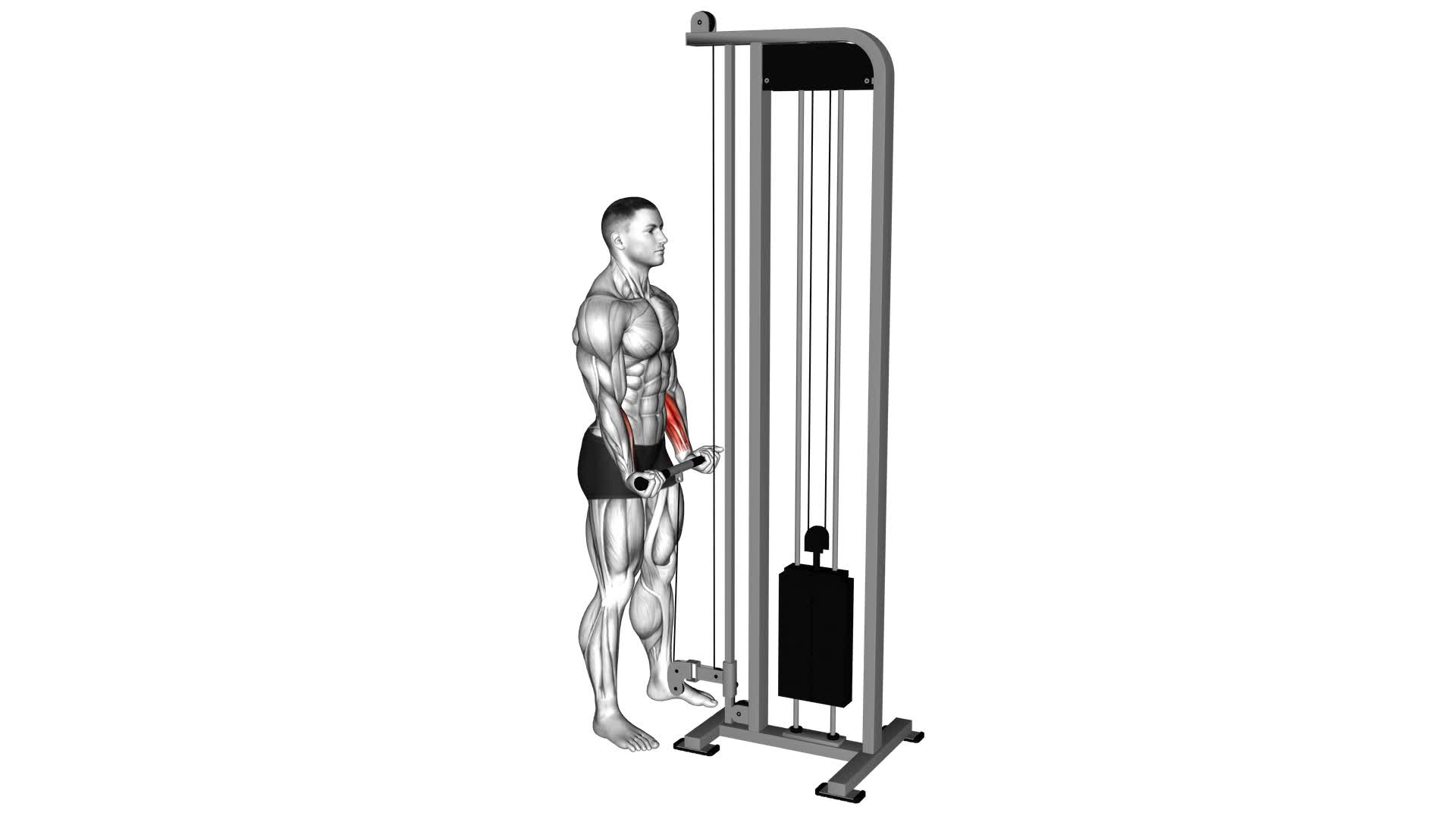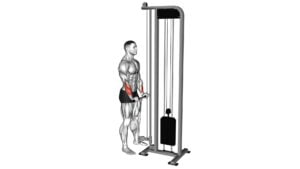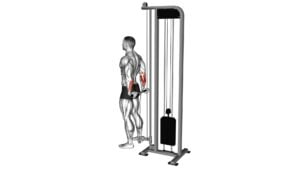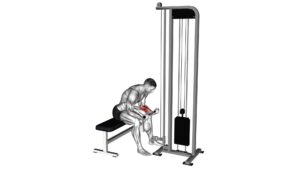Cable Standing Wrist Curl – Video Exercise Guide & Tips

Looking to strengthen your wrists? Check out the Cable Standing Wrist Curl exercise!
Watch This Exercise Video
This video exercise guide and tips will help you improve your wrist strength and flexibility.
With just a cable machine, you can perform this exercise to target your forearms and build stronger wrists.
Learn the proper form and technique, avoid common mistakes, and maximize your results with this effective exercise.
Get ready to take your wrist strength to the next level!
Key Takeaways
- Cable standing wrist curl helps improve wrist strength and stability.
- It targets the muscles in the forearms and wrists, enhancing overall wrist stability and grip strength.
- This exercise can help prevent common wrist injuries such as sprains and strains.
- Cable standing wrist curl improves flexibility and range of motion in the wrists.
Benefits of Cable Standing Wrist Curl
You can gain several benefits from performing the cable standing wrist curl exercise. This exercise is an effective way to improve wrist strength and promote injury prevention for your wrists. By incorporating this exercise into your routine, you can target the muscles in your forearms and wrists, helping to build strength and stability in these areas.
Wrist strength training is crucial for many everyday activities, such as lifting heavy objects, performing manual labor, or participating in sports that involve gripping and twisting motions. By regularly performing cable standing wrist curls, you can increase the strength of your wrist flexors and extensors, which will enhance your overall wrist stability and grip strength.
In addition to wrist strength training, the cable standing wrist curl exercise also helps in injury prevention for wrists. By strengthening the muscles and tendons in your wrists, you can reduce the risk of common injuries such as sprains and strains. This exercise also improves the flexibility and range of motion in your wrists, allowing you to move more freely and comfortably.
Equipment Needed for Cable Standing Wrist Curl
To perform the Cable Standing Wrist Curl exercise, you'll need specific equipment. The main equipment required for this exercise is a cable machine with an adjustable pulley system. The cable machine should have a handle attachment that allows you to grip it comfortably with your hands. Additionally, you'll need a weight plate to attach to the cable machine for resistance.
The cable machine provides a constant tension throughout the exercise, which helps to strengthen your wrists effectively. It also allows you to adjust the weight according to your strength level and progress over time. The handle attachment ensures a secure grip and allows for proper wrist alignment during the exercise.
If you don't have access to a cable machine, there are alternative exercises you can do to strengthen your wrists. Some options include dumbbell wrist curls, barbell wrist curls, and wrist roller exercises. These exercises can be performed with free weights and provide a similar range of motion and resistance as the cable standing wrist curl.
Proper Form and Technique for Cable Standing Wrist Curl
To perform the cable standing wrist curl with proper form and technique, it's important to pay attention to your wrist position. Make sure to keep your wrists straight and aligned with your forearms throughout the exercise to avoid any unnecessary strain.
Additionally, selecting the proper resistance is essential to ensure that you're effectively targeting your wrist muscles.
Wrist Position Importance
Regularly check and adjust your wrist position to ensure proper form and technique during the cable standing wrist curl exercise. Proper wrist positioning is crucial for maximizing results and preventing injuries.
When performing the cable standing wrist curl, your wrists should be in a neutral position, neither flexed nor extended. This allows for optimal activation of the forearm muscles and minimizes strain on the wrist joint. Avoid excessive bending or twisting of the wrists, as this can lead to discomfort or even injury.
Additionally, maintaining good wrist flexibility is important for performing the exercise correctly. Stretching and mobility exercises targeting the wrist joint can help improve flexibility and enhance your performance during the cable standing wrist curl exercise.
Proper Resistance Selection
Select the appropriate resistance level for the cable standing wrist curl exercise to ensure proper form and technique. Proper resistance selection is crucial for maximizing results and preventing injury.
When choosing the resistance, start with a weight that allows you to perform the exercise with good form and without straining. It should be challenging enough to stimulate the muscles but not so heavy that it compromises your technique.
As you become stronger and more comfortable with the exercise, gradually increase the resistance to continue progressing. Remember to listen to your body and adjust the weight accordingly.
Common Mistakes to Avoid
One common mistake to avoid when performing the cable standing wrist curl exercise is allowing your wrists to bend or flex during the movement. Maintaining a straight wrist throughout the exercise is crucial for proper form and technique. By keeping your wrists in a neutral position, you target the muscles in your forearms more effectively, maximizing the benefits of the wrist curl technique.
Bending or flexing your wrists not only reduces the effectiveness of the exercise but also increases the risk of injury. Remember to keep your wrists locked in place and focus on contracting the muscles in your forearms as you perform the wrist curl. This will help you achieve optimal results and minimize the chances of any potential harm.
Variations and Progressions of Cable Standing Wrist Curl
To progress in the cable standing wrist curl exercise, you can increase the weight you use. Start with a comfortable weight and gradually add more as you get stronger.
Another way to vary the exercise is by trying different grip variations, such as using an overhand grip or an underhand grip. These variations can target different muscles in your forearms and provide a new challenge to your workout routine.
Increased Weight for Progressions
As you progress in your cable standing wrist curl exercises, you can increase the weight to challenge your muscles even more. This advanced technique allows you to continue pushing your limits and achieving greater strength gains.
Here are some ways to incorporate increased weight into your cable standing wrist curl progressions:
- Gradually increase the weight load by adding small increments each week.
- Use a weight that allows you to perform the exercise with proper form and without compromising your wrists.
- Aim for a weight that allows you to complete 8-12 repetitions with proper technique.
- Take adequate rest between sets to ensure maximum effort and recovery.
- Listen to your body and adjust the weight accordingly if it feels too heavy or too light.
Different Grip Variations
Try incorporating different grip variations into your cable standing wrist curl exercises to target different muscles and add variety to your workout. By changing your grip, you can engage various muscles in your forearms and enhance your forearm strength.
One grip variation is the pronated grip, where your palms face down. This targets the flexor muscles in your forearms.
Another variation is the supinated grip, where your palms face up. This focuses on the extensor muscles.
You can also try the neutral grip, where your palms face each other. This targets both the flexors and extensors.
Experiment with these different grip variations to challenge your muscles in new ways and achieve a well-rounded forearm workout.
Common Mistakes to Avoid During Cable Standing Wrist Curl
Avoiding these common mistakes will help you maximize the effectiveness of your cable standing wrist curl exercise. Here are some key errors to watch out for:
- Improper hand positioning: Make sure to keep your hands in a neutral position throughout the exercise. Avoid excessive flexion or extension of the wrists, as this can lead to strain or injury.
- Poor posture: It's important to maintain proper posture during the exercise. Stand tall with your shoulders back and down, and engage your core to stabilize your body. Avoid leaning forward or backward, as this can compromise the effectiveness of the exercise and increase the risk of injury.
- Using too much weight: Start with a lighter weight and gradually increase as your strength improves. Using too much weight can lead to improper form and increase the risk of injury.
- Relying on momentum: Focus on slow and controlled movements throughout the exercise. Avoid using momentum or swinging the weight, as this takes away from the targeted muscle engagement.
- Neglecting the full range of motion: Make sure to fully extend your wrists at the top of the movement and flex them as much as possible at the bottom. Neglecting the full range of motion can limit the effectiveness of the exercise.
By avoiding these common mistakes, you can ensure that you're performing the cable standing wrist curl exercise correctly and efficiently.
Now, let's move on to some tips to maximize your results with this exercise.
Tips to Maximize Results With Cable Standing Wrist Curl
To maximize your results with the cable standing wrist curl, focus on proper form and technique. This exercise is great for maximizing forearm strength and improving wrist flexibility and mobility.
Here are some tips to help you get the most out of your cable standing wrist curl workout.
First, make sure to maintain a neutral wrist position throughout the exercise. Avoid bending your wrists too much or letting them flop backward. This will ensure that you're targeting the muscles in your forearms effectively.
Second, use a weight that challenges you but still allows you to maintain proper form. Starting with lighter weights and gradually increasing the resistance will help you build strength without risking injury.
Third, perform the exercise in a slow and controlled manner. Avoid using momentum or swinging your arms to lift the weight. This will engage your forearm muscles more effectively and prevent strain on your wrists.
Lastly, incorporate variations into your routine to target different areas of your forearms. Try using different grips, such as an overhand grip or an underhand grip, to work different muscle groups.
Frequently Asked Questions
How Many Sets and Reps Should I Do for Cable Standing Wrist Curls?
For cable standing wrist curls, you should aim for a moderate number of sets and reps to effectively target your wrist muscles. A common approach is to perform 3 sets of 12-15 reps. However, you can also vary the number of sets and reps based on your fitness level and goals.
Remember to start with a weight that challenges you but allows you to maintain proper form. Gradually increase the weight as you get stronger to keep progressing.
Can I Perform Cable Standing Wrist Curls With Dumbbells Instead of a Cable Machine?
Yes, you can perform dumbbell wrist curls instead of cable standing wrist curls.
While cable standing wrist curls offer the benefit of constant tension throughout the movement, dumbbell wrist curls can still effectively target your forearm muscles.
Using dumbbells allows for a greater range of motion and can help improve grip strength.
Just make sure to maintain proper form and start with lighter weights to avoid straining your wrists.
Is It Necessary to Use Wrist Wraps or Straps While Performing Cable Standing Wrist Curls?
Using wrist wraps or straps while performing cable standing wrist curls can provide several benefits. They can help to improve grip strength, reduce strain on the wrists, and enhance overall stability during the exercise.
When performing cable standing wrist curls, it's important to maintain proper form and technique. Keep your arms straight, engage your core, and focus on using your wrists to curl the weight towards your body.
Avoid using momentum and remember to breathe throughout the exercise.
Can Cable Standing Wrist Curls Help Improve Grip Strength?
Cable standing wrist curls are a great exercise to improve your grip strength. By incorporating them into your forearm workout routine, you can experience several benefits.
These curls specifically target the muscles in your wrists and forearms, helping to strengthen them and enhance your ability to grip and hold onto objects.
To properly execute cable standing wrist curls for maximum grip strength gains, ensure that your form is correct and use a weight that challenges you without compromising your technique.
Are There Any Alternative Exercises That Target the Same Muscles as Cable Standing Wrist Curls?
Looking for alternative exercises that target the same muscles as cable standing wrist curls?
There are several options you can try.
One alternative is the dumbbell wrist curl, which can be done seated or standing.
Another option is the barbell wrist curl, where you hold a barbell and curl your wrists upward.
Lastly, you can also try using a wrist roller, which involves rolling a weight up and down with your wrists.
These exercises can help strengthen the same muscles as cable standing wrist curls.
Conclusion
In conclusion, the cable standing wrist curl is a highly effective exercise for strengthening and toning the wrist muscles. By using the proper form and technique, you can maximize your results and avoid common mistakes.
Additionally, there are variations and progressions available to challenge yourself as you become stronger.
With the right equipment and consistency, this exercise can greatly benefit your overall wrist strength and stability.

Author
Years ago, the spark of my life’s passion ignited in my mind the moment I stepped into the local gym for the first time. The inaugural bead of perspiration, the initial endeavor, the very first surge of endorphins, and a sense of pride that washed over me post-workout marked the beginning of my deep-seated interest in strength sports, fitness, and sports nutrition. This very curiosity blossomed rapidly into a profound fascination, propelling me to earn a Master’s degree in Physical Education from the Academy of Physical Education in Krakow, followed by a Sports Manager diploma from the Jagiellonian University. My journey of growth led me to gain more specialized qualifications, such as being a certified personal trainer with a focus on sports dietetics, a lifeguard, and an instructor for wellness and corrective gymnastics. Theoretical knowledge paired seamlessly with practical experience, reinforcing my belief that the transformation of individuals under my guidance was also a reflection of my personal growth. This belief holds true even today. Each day, I strive to push the boundaries and explore new realms. These realms gently elevate me to greater heights. The unique combination of passion for my field and the continuous quest for growth fuels my drive to break new ground.







